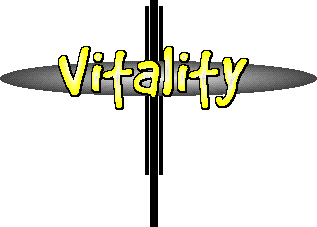
Vitality:
Vitality is a measure of somethings ability to withstand and survive, damage of any sort. Something, or someone with a high amount of vitality can withstand or survive a large amount of damage. Arnold Schwarzeneger has a high amount of vitality. A snail has a low amount of vitality. These rules describe vitality in three different ways. By vitality base, potential, and points.
Vitality Base:
Vitality base (Vb) is measured using one of the different sided dice used in a Fantasy Role Playing game. For example; someone with a low vitality base (A wizard), would measure their vitality using a 4 sided die. Whereas something with a high vitality base (An iron door) might measure that vitality using a 20 sided die.
Vitality potential:
Vitality potential (Vp) is the number of vitality base dice used when determining the vitality of a person or thing, or the range of possible vitality points that such a combination can generate. For example a crystal set of wind chimes may have 1d4 vitality potential. Which could yield 1 to 4 vitality points. A warrior with many years of experience might have 12d10 potential. Which would yield anywhere from 12 to 120 vitality points. Thus vitality potential can be described as 12d10 or as 12-120 vitality points. As characters in a role playing game accumulate experience they learn ways to avoid, withstand and mitigate greater amounts of damage. Thus their vitality potential rises in conjunction with their skill level.
Vitality Points:
The number of vitality points (VP) that anything or anyone has is used to describe the amount of damage that that person or thing is capable of withstanding/absorbing before dying or being destroyed. In the case of a Player character the number of vitality points is known, and increases by one base die per level of experience. Whereas the number of vitality points that a monster or piece of wood has may not be known initially. In this case the object or creatures vitality potential is described, and the GM must determine the actual number of vitality points based on that potential. For example; A skeleton may be described as having 1d8 potential. This permits the GM some flexibility in game play. The GM may roll a d8 and determine the Skeletons vitality points randomly. Or he/she may determine the Skeletons vitality points from it's potential based on other factors such as how powerful the group of adventurers is, or how long it's been since they have had some rest.
converting this system of Vitality rules to that used in your campaign should be relatively easy now that I have explained Vitality base, potential and number. Of course, you may decide that my method is more logical; easier to understand and use, as well as Free! That's right, you may use my method at no cost to you. Of course; I still retain copyright to this method/rule. Please don't try to steal or sell my ideas. It just wouldn't be right :-(
Please see the "Disclaimer" for some legalize gobledegook.
Link to the Defensive/Protective Ratings rules.
Link to the Strike Number rules page.
Return to the Rob's World Campaign page.
Last updated:Thu, Jul 30, 1998 18:29
This page has been accessed times since 29 Jul 1998.